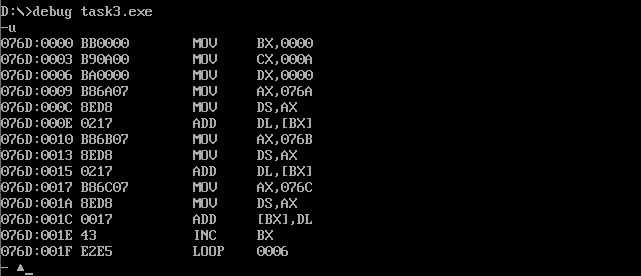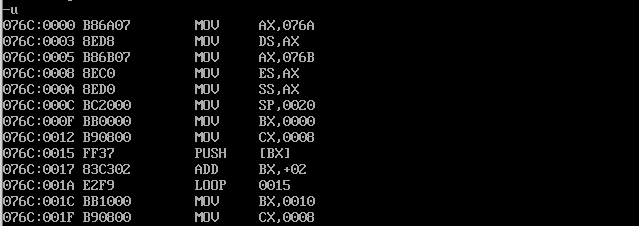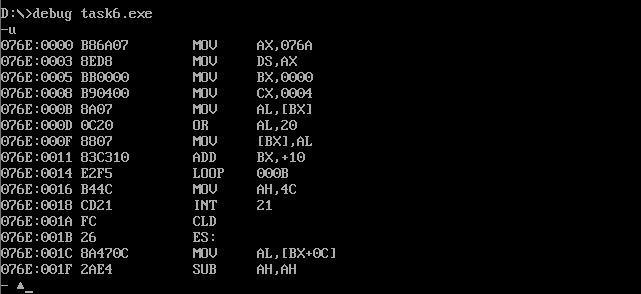Experiment Task 1
Tasks 1-1
task1_1.asm source
assume ds:data, cs:code, ss:stack data segment db 16 dup(0) ; Reserve 16 byte cells with initial values of 0 data ends stack segment db 16 dup(0) ;Reserve 16 byte cells with initial values of 0 stack ends code segment start: mov ax, data mov ds, ax mov ax, stack mov ss, ax mov sp, 16 ; Set top of stack mov ah, 4ch int 21h code ends end start
task1_1 Debug to end of line17, screenshot before line19

Question Answer
(1) In debug, before the end of line17 and line19, record this time: Register (DS) = _076A_u, Register (SS)
= _ 076B_u, Register (CS) = u 076C_u
(2) Assuming that the segment address of the code segment is X after loading the program, the segment address of the data segment is u X-2h_u, The segment address of the stack is
__X-h__.
Tasks 1-2
Task task1_2.asm source
assume ds:data, cs:code, ss:stack data segment db 4 dup(0) ; Reserve 4 byte cells with initial values of 0 data ends stack segment db 8 dup(0) ; Reserve 8 byte units with initial values of 0 stack ends code segment start: mov ax, data mov ds, ax mov ax, stack mov ss, ax mov sp, 8 ; Set top of stack mov ah, 4ch int 21h code ends end start
task1_2 View screenshots of register DS, CS, SS values before debugging to the end of line17 and before line19

Question Answer
(1) In debug, before the end of line17 and line19, record this time: Register (DS) = _076A_u, Register (SS)
= u 076B_u, Register (CS) = u 076C_u
(2) Assuming that the segment address of the code segment is X after loading the program, the segment address of the data segment is _ X-2h_u, The segment address of the stack is
__X-h__.
Tasks 1-3
Task task1_3.asm source
assume ds:data, cs:code, ss:stack data segment db 20 dup(0) ; Reserve 20 byte units with initial values of 0 data ends stack segment db 20 dup(0) ; Reserve 20 byte units with initial values of 0 stack ends code segment start: mov ax, data mov ds, ax mov ax, stack mov ss, ax mov sp, 20 ; Set Initial Stack Top mov ah, 4ch int 21h code ends end start
task1_3 View screenshots of register DS, CS, SS values before debugging to the end of line17 and before line19

Question Answer
(1) In debug, before the end of line17 and line19, record this time: Register (DS) = _076A_u, Register (SS)
= u 076C_, Register (CS) = _076E_u_
(2) Assuming that the segment address of the code segment is X after loading the program, the segment address of the data segment is u X-4h_u, The segment address of the stack is
__X-2h__.
Tasks 1-4
Task task1_4.asm source
assume ds:data, cs:code, ss:stack code segment start: mov ax, data mov ds, ax mov ax, stack mov ss, ax mov sp, 20 mov ah, 4ch int 21h code ends data segment db 20 dup(0) data ends stack segment db 20 dup(0) stack ends end start
task1_4 View screenshots of register DS, CS, SS values before debugging to the end of line17 and line19

Question Answer
(1) Before the end of line9 and line11 in debug, record this time: Register (DS) = u 076E_u, Register (SS)=
_ 076C_u, Register (CS) = u 076A_u
(2) Assuming that the segment address of the code segment is X_u after loading the program, Then, the segment address of the data segment is u X+2h_u, Segment address of stack
Yes_u X+4h_u.
Tasks 1-5
Based on the practice and observation of the above four experimental tasks, summarize and answer:
(1) For a segment defined below, the amount of memory space actually allocated to that segment after loading is u (Data length / 16) bytes.
(2) If the program task1_ 1.asm, task1_ 2.asm, task1_ 3.asm, task1_ 4. In asm, the pseudo-directive end start is changed to
end, which program can still be executed correctly. Combined with the conclusions obtained from practical observation, the reasons are analyzed and explained.
Experiment Task Two
Source code:
assume cs:code
code segment
start:
mov ax, 0b800h
mov ds, ax
mov bx, 0f00h
mov cx, 50h
mov ax, 0403h
s: mov ds:[bx], ax
add bx, 2
loop s
mov ah, 4ch
int 21h
code ends
end start
Run screenshots:

Experiment Task Three
Completed assembly source code:
assume ds:data1, cs:code
data1 segment
db 50, 48, 50, 50, 0, 48, 49, 0, 48, 49 ; ten numbers
data1 ends
data2 segment
db 0, 0, 0, 0, 47, 0, 0, 47, 0, 0 ; ten numbers
data2 ends
data3 segment
db 16 dup(0)
data3 ends
code segment
start:
mov ax, data1
mov ds, ax
mov bx, 0
mov cx, 0ah
s: mov ax, ds:[bx]
add ax, ds:[bx+10h]
mov ds:[bx+20h], ax
inc bx
loop s
mov ah, 4ch
int 21h
code ends
end start
Disassembly:

Before adding:

When added:

Experiment Task Four
Completed assembly source code
assume cs:code, ss:stack
data1 segment
dw 2, 0, 4, 9, 2, 0, 1, 9
data1 ends
data2 segment
dw 8 dup(0)
data2 ends
; Defines a stack segment
stack segment
dw 8 dup(0)
stack ends
code segment
start:
mov ax, data1
mov ds, ax
mov sp, 9
mov bx, 0
mov cx, 8
s1: push ds:[bx]
add bx, 2
loop s1
mov ax, data2
mov ds, ax
mov bx, 0
mov cx, 8
s2: pop ds:[bx]
add bx, 2
loop s2
mov ah, 4ch
int 21h
code ends
end start
Debug in debug, disassemble results:

data2 corresponds to local memory space:

Experiment Task Five
task5.asm source code:
assume cs:code, ds:data
data segment
db 'Nuist'
db 2, 3, 4, 5, 6
data ends
code segment
start:
mov ax, data
mov ds, ax
mov ax, 0b800H
mov es, ax
mov cx, 5
mov si, 0
mov di, 0f00h
s: mov al, [si]
and al, 0dfh
mov es:[di], al
mov al, [5+si]
mov es:[di+1], al
inc si
add di, 2
loop s
mov ah, 4ch
int 21h
code ends
end start
Result of running code:

Modify the value of 5 byte units in line4, reassemble, link, run

line19 controls letter size
line4 controls the color of letters
Experimental Task Six
task6.asm source
assume cs:code, ds:data
data segment
db 'Pink Floyd '
db 'JOAN Baez '
db 'NEIL Young '
db 'Joan Lennon '
data ends
code segment
start:
mov ax, data
mov ds, ax
mov ax, data
mov es, ax
mov bx, 0
mov cx, 4
s1:
mov si, cx
mov cx, 4
s2:
mov al, es:[bx]
or al, 20h
mov es:[bx], al
inc bx
loop s2
mov cx, si
mov bx, 0
mov ax, es
inc ax
mov es, ax
loop s1
mov ah, 4ch
int 21h
code ends
end start
Load, disassemble, debug screenshots in debug

Screenshot of memory space corresponding to data segment:

Experimental Task Seven
task7.asm source
assume cs:code, ds:data, es:table
data segment
db '1975', '1976', '1977', '1978', '1979'
dw 16, 22, 382, 1356, 2390
dw 3, 7, 9, 13, 28
data ends
table segment
db 5 dup( 16 dup(' ') ) ;
table ends
code segment
start:
mov ah, 4ch
int 21h
code ends
end start
Screenshot of table segment raw data information

Screenshot of memory space corresponding to table segment

Information is structurally written to specified memory on demand